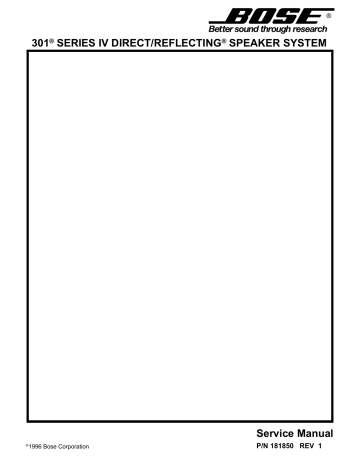TEST PROCEDURES. Bose 301 Series III
Add to My manuals12 Pages
The Bose 301 Series III speakers deliver spacious and detailed sound for your home audio system. With their high power handling and wide frequency response, these speakers can reproduce music and movies with clarity and realism. The two-piece design allows for flexible placement, and the included mounting brackets make it easy to hang them on the wall.
advertisement

TEST PROCEDURES
Note: Before performing any tests, remove both grilles by following the grille removal instructions in the disassembly section of this manual.
Note: There should not be any buzzes or rattles from within the speaker cabinet. Redress any wire or component that buzzes.
1. Woofer Rub and Tick Test: Connect the output of a signal generator to the input of a power amplifier. Connect the output of the power amplifier to the input terminals of the speaker under test, (see Figure 1). Adjust the frequency of the generator to 45 Hz and the amplifier output to 8 Vrms. No extraneous noises such as rubbing, scraping or ticking should be heard.
3. Tweeter Sweep Test: Reduce the amplifier output to 3 Vrms and continue sweeping from 5 kHz to 15 kHz. Replace either of the tweeters in which buzzing or distortion occurs.
4. Air Leak Test: Using an 8 Vrms signal, set the generator frequency to 45 Hz. Listen for air leaks around the woofer, tweeters and cabinet seams (glue joints). Any air leaks will be heard as a sputtering or hissing sound. The repair of air leaks can be made by repositioning the transducer gaskets.
Note: To distinguish between normal suspension noise and rubs or ticks, slightly displace the cone of the woofer with your fingers. If the noise can be made to go away or get worse, it is a rub or tick and the woofer should be replaced. If the noise stays the same, it is normal suspension noise and the woofer is fine. Suspension noises will not be heard with program material.
5. Woofer Phase Test:
Note: In this test, supply voltage should only be momentarily applied to the speaker input terminals to avoid possible damage to the speaker.
2. Woofer Sweep Test: Sweep the signal generator from 10 Hz to 5 kHz using the 8 Vrms signal.
There should be no loud extraneous sounds. If there are any loud buzzes or distortion, replace the woofer.
Set a DC power supply to 8 volts. To ensure that the woofer is connected in phase, connect the positive lead of the supply to the positive (+) speaker input terminal and the negative lead to the negative (-) input terminal. The woofer should move outwards with the application of the supply voltage.
Test Connections, 301 ® Series IV Speaker
Audio Signal
Generator Power Amplifier
Input Output
-
+ -
+ +
Back of Speaker
Under Test
Black ( - )
5
RIGHT
Red ( + )
FIGURE 1
advertisement
Related manuals
advertisement
Table of contents
- 3 SERIES IV TECHNICAL DESCRIPTION
- 3 SPECIFICATIONS
- 4 DISASSEMBLY/ASSEMBLY PROCEDURES
- 4 1. Grille Removal
- 4 2. Woofer Removal/Replacement
- 4 3. 3" Tweeter Removal/Replacement
- 5 5. Remounting the Grille
- 6 TEST PROCEDURES
- 6 1. Woofer Rub and Tick Test
- 6 2. Woofer Sweep Test
- 6 3. Tweeter Sweep Test
- 6 5. Woofer Phase Test
- 7 6. Tweeter Phase Test
- 7 7. Crossover Testing
- 8 Figure 3: 301 Series IV Main Assembly Drawing
- 9 Figure 4: 301 Series IV Packaging Parts Drawing
- 10 301 Series IV Main Assembly Parts List
- 11 301 Series IV Crossover Parts List
- 11 301 Series IV Main Packaging Parts List